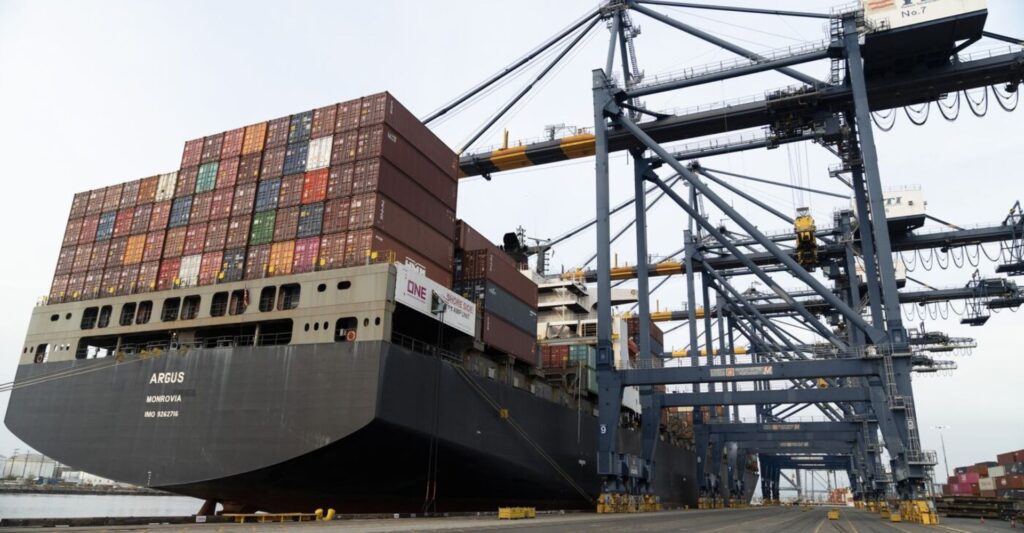STAX’s Innovative Multi-Port Emissions System Launched to Clean California’s Air

|
Listen to this story:
|
First-of-its-kind technology treats vessel-born emissions with more than 95% efficacy, bringing legacy ocean-going vessels into California Air Resources Board compliance and drastically improving air quality in port communities
STAX Engineering, a leader in maritime emissions capture and control, launched the first multi-port emissions reduction operation in California at the Ports of Los Angeles, Long Beach, and Oakland. STAX, a grantee of the California Air Resources Board (CARB), is the only provider authorized to service container vessels in California and is the first to successfully test and submit for CARB approval for auto carrier operations. These two types of vessels are among the most substantial sources of emissions in global shipping ports. At full scale, STAX is on track to treat more than 1,000 tons of shipping emissions per year by 2025.
“We envision a future with universally clean air and have focused our first efforts on an industry with some of the biggest air quality hurdles—industrial shipping,” said Mike Walker, CEO of STAX. “California is just the beginning. Ocean-going shipping vessels around the globe are big polluters, have long shelf lives, and are really difficult to refurbish with cleaner technologies. We bridge the gap between the present and a clean-air future by transforming those essential, enduring shipping assets into eco-friendly ones without costly retrofitting or slowing down productivity.”
The shipping industry is one of the world’s most significant contributors of pollutants and other harmful emissions. It accounts for over 80% of the world’s trade volume and nearly 3% of global greenhouse gas emissions (UNCTAD). If left unmitigated, that 3% could reach 10% by 2050 (CE Delft). Two of STAX’s inaugural ports, the Ports of Los Angeles and Long Beach, alone produce 100 tons of smog every day, more than the daily emissions of six million cars (EESI). This kind of fine particulate pollution can embed in people’s lungs and bloodstreams when inhaled, causing health impacts such as premature death, increased hospitalizations for heart and lung illnesses, and asthma attacks. The elderly, children, and people with chronic heart or lung disease are especially at risk of these adverse health impacts. Furthermore, the communities near ports tend to be home to low-income residents and people of color who are already overburdened with multiple sources of pollution.
To combat this, CARB, the standard bearer for air quality regulation in the US, implemented new rules mandating that ocean-going vessels in California must connect to shore power when at-berth or retrofit vessels to avoid auxiliary engine and auxiliary boiler exhaust. A significant portion of in-service ocean-going vessels are not built in compliance with the new mandates; retrofitting costs hover around $2 million per vessel in addition to associated utility costs.
As an accessible and immediately viable alternative, STAX offers land- and barge-based, mobile emissions capture and control technology to shipping terminal and fleet operators for a nominal hourly fee. STAX attaches to at-berth vessels through its patented, flexible exhaust capture system designed to accommodate all ships without modification—even in the most congested ports. Once exhaust is captured and funneled into the STAX system, it is filtered. STAX removes 99% of particulate matter (PM) and 95% of oxides of nitrogen (NOx) before being released as purified gas. To date, STAX has treated 44 at-berth vessels for a cumulative of 2,700 hours and 20.3 tons of pollutants controlled—and counting.
Related Article: Ford, Other Industry Leaders Support Strengthened EPA Standards on Heavy-Duty Vehicle Emissions
“We’ve created a cost-effective and versatile system that brings existing assets and facilities into increasingly strict air quality compliance. And we’ve done it in a way that maintains their longevity while keeping production at full tilt,” said Bob Sharp, founder, president, and CTO of STAX. “Today, our focus is industrial shipping. However, our modular, mobile technology has the potential to be industry-agnostic. Our ultimate goal is to treat 500 million tons of CO2 annually, accounting for 1% of global CO2 emissions.”
STAX leadership boasts over 30 years of maritime operations and emissions control experience. In addition to the currently operational sites at the Ports of Los Angeles, Long Beach, and Oakland, STAX plans to expand its fleet with 18 new barges and operations in several additional ports across the US by 2025. Later this quarter, STAX will begin testing for tanker-class vessels, known for being the most challenging to treat due to heightened safety requirements. STAX anticipates gaining CARB permitting for tanker operations later this year.










